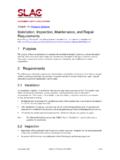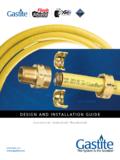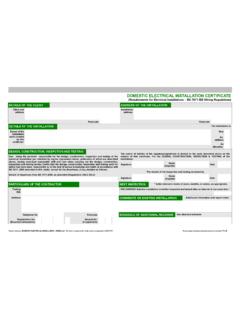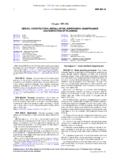Transcription of WIRING, SPECIFICATIONS, INSPECTION, AND …
1 wiring , SPECIFICATIONS, inspection , AND METER installation PROCEDURES FOR RESIDENTIAL CUSTOMERS SERVED BY SOUTHWEST ARKANSAS ELECTRIC COOPERATIVE CORPORATION Effective April 1, 1974 Revised February 3, 2014 (Condensed from National Electric Code) This condensed version of residential wiring specifications has been prepared and adopted by the Cooperative for the following purposes: To assist customers of the Cooperative in securing electrical service wiring to their homes and elsewhere on their premises which will meet recognized safety standards, and which will provide adequate capacity for their present and future load requirements. To assure customers of the Cooperative of reliable and economical service from the electrical wiring system installed on source side of the meter. To establish standard residential meter wiring specifications for use by customers of the Cooperative, electricians and wiring inspectors.
2 In general, inspection and testing of the electric wiring installation by the Cooperative will include and will be limited to the following: Service and construction personnel will inspect meter loops (and associated wiring ) mounted on residences up to the first secondary thermal disconnect or main breaker (whether located inside or outside the residence). Pole mounted meter loops and associated wiring will continue to be inspected down to ground level. Test for proper voltage delivered to the main disconnect circuit-breaker at the service entrance. The customer and the electrician are responsible for making necessary voltage tests to assure that adequate capacity is provided and that proper voltages are delivered to lighting fixtures, appliances, and equipment installed in the residence and elsewhere on the premises of the customer.
3 The wiring inspection will assure that recognized safety standards have been met and that the electrical wiring system has adequate capacity. Voltage and capacity characteristics within the wiring system on the customer's side of the main disconnect circuit-breaker at the service entrance are the responsibility of the customer and the electrician. The minimum standards of the NEC shall apply where wiring material and installation requirements are not specifically covered by these specifications. wiring specifications, inspection , and meter installation procedures for residential customers served by the Cooperative are as follows: Section A. - Meter installation Specifications: 1. The meter shall, in all cases, be installed by the Cooperative and ownership of the meter shall be retained by the Cooperative.
4 2. The meter shall be installed on the exterior surface of the building wall or on a pole. Cooperative personnel shall have unimpeded access to the meter at all times. 3. The meter shall be installed so that the center of the meter is at least 5 feet but not more than 6 feet above ground level. 4. A meter socket intended for installation on the wall of a building or on a pole shall be furnished by the customer. Ownership of the meter socket shall be retained by the customer. It shall be the responsibility of the customer to maintain said meter socket in good working order. The meter socket shall be of a type and design which meets Cooperative approval. Section B. - Service Entrance Specifications: 1. The service entrance shall be furnished, owned, and maintained by the customer. The service entrance on a house or other building shall be constructed as a meter loop where no separate meter loop is provided.
5 A typical house meter loop for overhead service is shown in Exhibit A. 2. The service entrance shall have a minimum capacity of 60 amperes, 120/240 volts. The service entrance should be of adequate capacity to carry the total residential load as determined for load calculation recommendations in the NEC, including capacity for anticipated future loads. 3. Conduit used to construct the service entrance for overhead service shall be of rigid design; and may be galvanized steel or aluminum. EMT or IMC is NOT permitted. Conduit which extends through the roof as a service mast shall be as least 2 1/2 " rigid galvanized steel, and shall extend to a height of between 2'-6" and 3'-0" above the roof at the point of emergence. For underground service, conduit shall extend from the meter socket to a point 18 inches below ground level with an insulating bushing installed on the top end.
6 Said conduit shall be 2" pipe size or larger and shall be constructed of either galvanized rigid steel or PVC, "schedule 80". 4. Conductors installed in service entrance conduit shall not exceed the maximum number for conduit sizes shown in Table I. 5. Service entrance conductors for overhead service shall be installed in conduit. At least 18 inches of the conductors shall extend through the weatherhead for the service connection. The weatherhead shall be installed near the eave of the building with the bottom of the drip loop at least 12 feet above ground level. For underground service, a continuous and unbroken underground service cable shall be installed by the Cooperative from the meter socket lugs or from an outside junction box as specified in Table III to the service pedestal or transformer; and in the event the meter loop is located on a pole, the underground service cable to the service entrance shall be furnished and installed by the customer.
7 Trenches for installing underground service cables from the pole meter loop shall be furnished and backfilled by the customer in accordance with NEC codes. 6. Conductors in the service entrance, other than the underground service cable, shall be stranded wire; may be either copper or aluminum; shall be covered with type TW or THW or better insulation; and shall be properly sized as shown in Table II for the service entrance capacity required. For service entrance capacity in excess of 200 amps, follow ampere rating of conductors in the NEC. 7. Overcurrent protection shall be circuit-breaker type. Main-circuit panels or main circuit-breakers shall be located within 18 inches of the meter socket or outside junction box. The ampere rating of the main disconnect circuit breaker shall not exceed the amperage rating of the service entrance conductors installed to the main-circuit panel as shown in Table II.
8 8. Ground wire shall be at least #6 AWG solid copper, shall be bonded to the neutral wire at the weatherhead for overhead service, and shall extend continuously and unbroken outside the conduit to the ground rod with bonding to the meter base and any other electrical panels attached thereto; except when a service mast extends through the roof, the ground wire may be run through the meter socket and inside the conduit. For underground service, the ground wire shall be connected to the neutral lug of the meter socket and extend continuously and unbroken outside the conduit to the ground rod. For overhead or underground service, the ground wire shall be attached to the ground rod with a proper type clamp. 9. The ground rod shall be a minimum size 5/8" X 8' solid galvanized steel or copperweld ground rod. 10.
9 Service entrance outlet receptacles for mobile homes shall be grounded and polarized in accordance with NEC standards. Section C. - Pole Meter Loop Specifications: 1. The pole meter loop, except for the meter, shall be furnished, owned and maintained by the customer. The permanent meter loop shall be completely wired and assembled by the customer or electrician for installation by the Cooperative on a pole furnished and installed by the Cooperative. A typical pole meter loop for overhead service is shown in Exhibit B, and a typical meter loop for underground service is shown in Exhibit D. Poles and meter loops for temporary overhead and underground service shall be furnished and installed by the customer at locations approved by the Cooperative. Temporary poles and meter loops shall conform to the specifications set forth in Section I.
10 2. The pole meter loop shall have a minimum capacity of 60 amperes, 120/240 volts for the residential load to be served, with additional capacity for other loads to be connected to the pole meter loop. Use load calculation recommendations in the NEC to determine total meter loop capacity. 3. Conduit shall be used to construct the pole meter loop and shall be of rigid galvanized steel or aluminum design; EMT, IMC or PVC is NOT permitted. Conduit shall extend to a height of 15'-0" (minimum) above the meter socket hub to the weatherhead for overhead service. For underground service, either rigid galvanized steel or PVC schedule 80 conduit shall be installed from the meter socket to 18 inches below ground level with an insulating bushing installed on the top threaded connector. 4. Conductors installed in the pole meter loop conduit shall not exceed the maximum number for conduit sizes shown in Table I.







